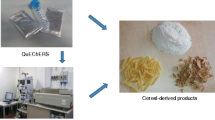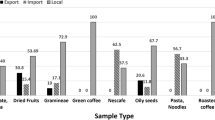Abstract
Within a joint research project entitled “Analysis and occurrence of importantFusarium toxins (deoxynivalenol and zearalenone) and dietary intake of these toxins by the German consumer”, supported by the German Federal Ministry of Consumer Protection, Food and Agriculture (BMVEL), representative analytical data are generated on the contamination level of foods withFusarium mycotoxins. This paper gives a comprehensive summary concerning the contamination of foods from the German market with deoxynivalenol (DON) in the period from August 2001 to April 2004. More than 4700 food samples (mostly cereals and cereal-containing foods) were purchased from food shops in Germany and analysed for DON by enzyme immunoassay, HPLC, and LC-MS/MS, respectively. All analytical methods were validated through intra- and interlaboratory studies and gave mean recoveries of >80% for each matrix. Although DON was detected with high frequency in all cerealcontaining samples, the mean and median levels were in most products well below the recently established maximum permitted limits in Germany.
Similar content being viewed by others
Literatur
Bundesministerium für Verbraucherschutz, Ernährung und Landwirtschaft (2004) Verordnung zur Änderung der Mykotoxin-Höchstmengenverordnung und der Diätverordnung. BGBl I 2004 I, Nr. 5, 151–152
Ellner FM (2001)Fusarium toxins in cereals—results from eight German Federal States in 2000. Mycotoxin Research 17A: 41–44
Majerus P, Curtui V, Otteneder H, Usleber E. (2002) Deoxynivalenol in Lebensmitteln: Ergebnisse einer Pilotstudie. Mycotoxin Research 18A: 32–34
Schollenberger M, Müller HM, Drochner, W (2002) Fusarium toxins in different food samples Mycotoxin Research 18A: 39–42
Taschan H, Puchtinger G, Waller U, Puchtinger, T (2000) Deoxynivalenol in grain products. Mycotoxin Research 16A: 26–29
Usleber E, Lepschy J, Märtlbauer E (2000) Deoxynivalenol in Mehlproben des Jahres 1999 aus dem Einzelhandel. Mycotoxin Research 16A: 30–33
Bockhorn I, Bockhorn A, Pohler S (2001) Deoxynivalenol (DON) in raw and cooked pasta. Mycotoxin Research 17A: 67–70
Prelusky DB, Trenholm HL, Lawrence GA, Scott PM (1984): Nontransmission of deoxynivalenol (vomitoxin) to milk following oral administration to dairy cows. J Environ Sci Health B, 19: 593–609
Côté LM, Dahlem AM, Yoshizawa T, Swanson SP, Buck WB (1986) Excretion of deoxynivalenol and its metabolite in milk, urine and faeces of lactating dairy cows. J Dairy Sci 69: 2416–2423
Author information
Authors and Affiliations
Corresponding author
Additional information
Financial support Bundesministerium für Verbraucherschutz. Ernahrung and Candwirtschaft (B. E. 00HS 055)
Rights and permissions
About this article
Cite this article
Curtui, V., Brockmeyer, A., Dietrich, R. et al. Deoxynivalenol in Lebensmitteln. Mycotox Res 21, 83–88 (2005). https://doi.org/10.1007/BF02954424
Issue Date:
DOI: https://doi.org/10.1007/BF02954424




